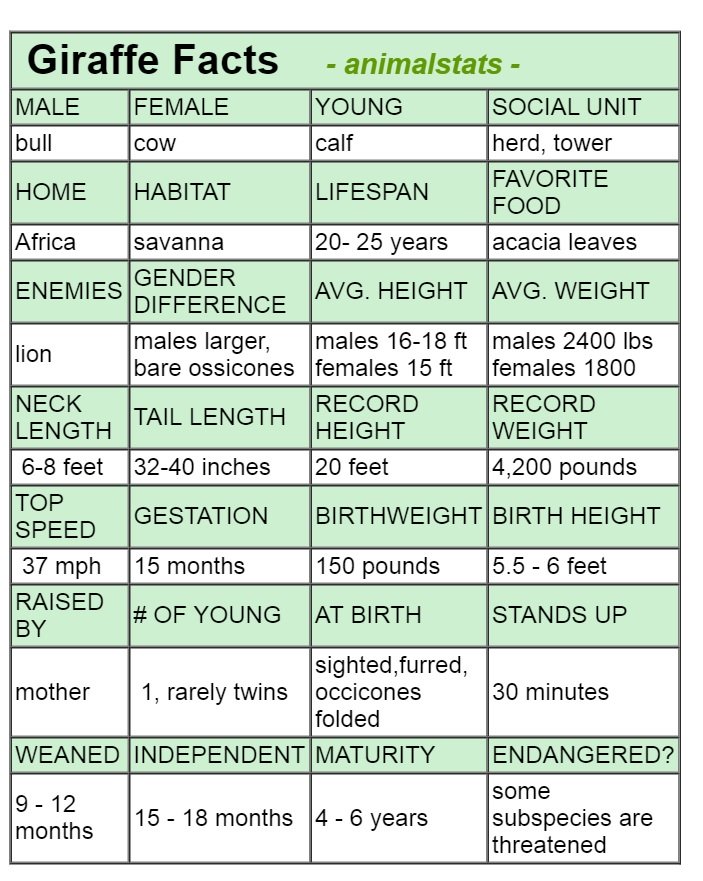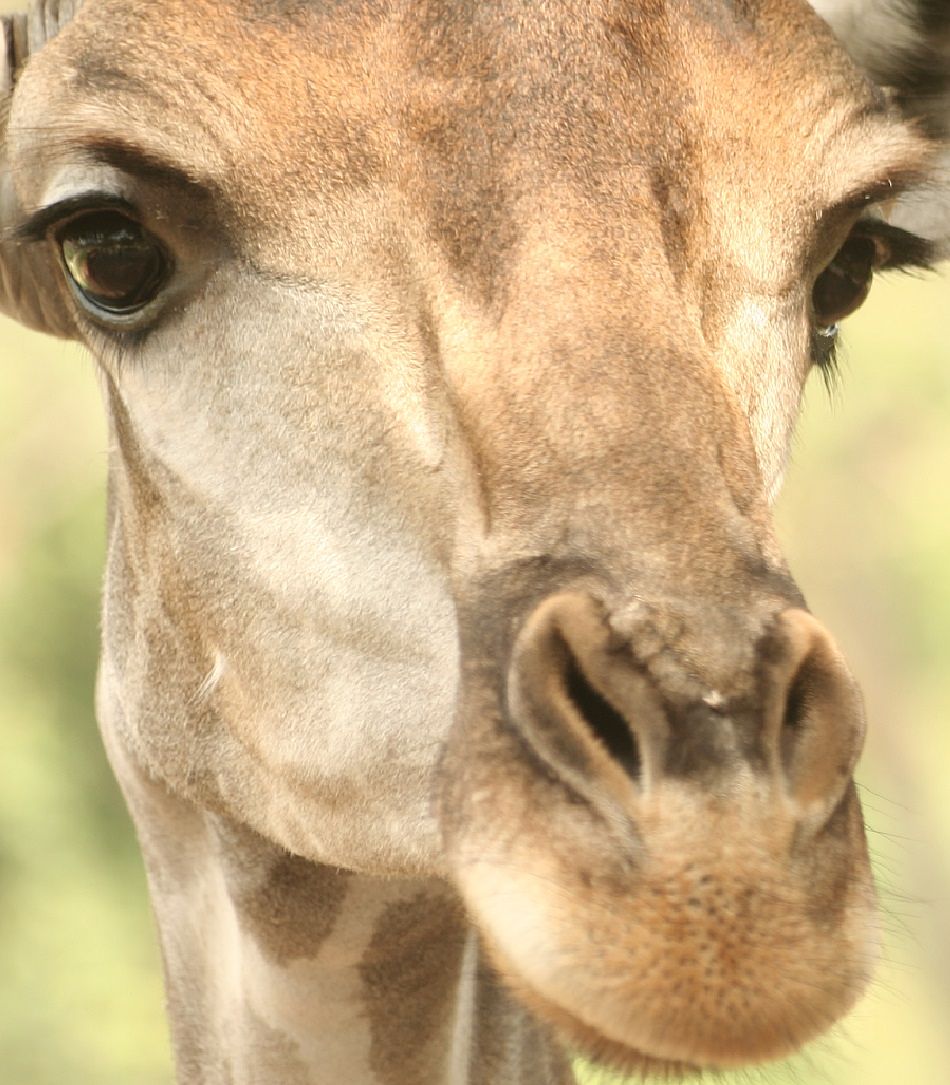giraffe Adaptions
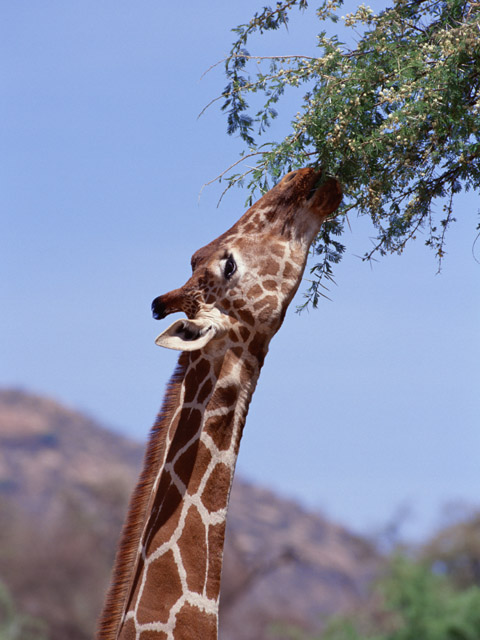 that neck!
that neck!Giraffe adaptions have allowed them to thrive in one of the harshest places on Earth, the African savanna.
The standout feature of the giraffe is, of course, that neck! So what kind of special adaptions must occur in order to make such a unique body function properly?
Today the giraffe is the tallest animal on Earth, with males topping out at about 18 feet at the top of the horns (called occicones), and 11 feet at the shoulder. Although no fossil trail exists, it is assumed the giraffe developed its remarkable physique and out-survived its relatives, by reaching for the treetops.
As taller individuals ate leaves and fruits unavailable to shorter individuals, the giraffe thrived, and became more and more specialized. While the 6 to 8 foot long, 600 pound neck is most obvious, the giraffes entire body is a masterpiece of specialization.
Viewed from the side, the giraffes shoulder region is towering, with a highly elongated pectoral girdle which gives the illusion that the front legs are longer than the rear. Front and rear legs are about the same length, however, between 5.5 and 6 feet long.
While the relatively short back has vertebrae of a median size, the vertebrae of the neck, are stretched to about 11 inches long, They still have the standard 7 neck vertebrae found in most mammals, including us, but they are not only elongated, but also articulate far more than ours.
The neck is supported by powerful muscles and reinforced ligaments which anchor to vertebrae between the shoulder blades, and form a hump where the back and neck meet.
The head is refined, streamlined and equipped with an 18 inch long tongue for even further reach.
Both males and females have horns known as "occicones", which are formed from cartilage and covered with skin. Females have thinner occicones, that are tufted with longer hair on top. Males occicones are larger, have knobs on the ends, and become bald on top as they mature.
 Awesome Giraffes!
Awesome Giraffes!
Giraffe Physical Adaptions
giraffes circulatory system
Behavioural Adaptions of a Giraffe
giraffes adaptions to their environment
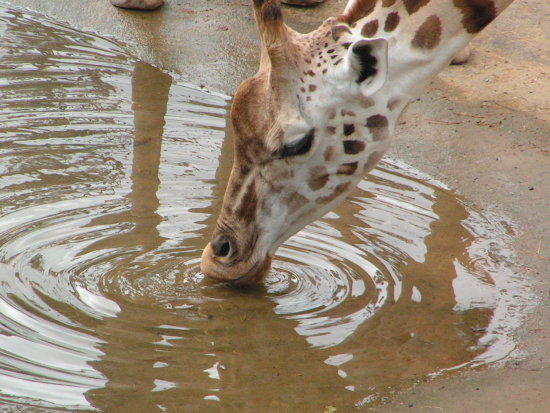 giraffe drinking
giraffe drinkingTo start with, the giraffe has a 25 pound heart capable of creating the extreme blood pressure required to pump blood 8 feet up to the brain. But when the giraffe lowers its head to
eat or drink, the blood rushing down at such high pressure would cause the blood vessels to burst. Pressure sensors along the neck’s arteries
monitor the blood pressure and activate contraction of the artery walls (along with other
mechanisms) to counter this increase in pressure.
The blood leaving the giraffe’s heart has to do more than just reach the level of the head, it has to be at a high enough pressure to pass through all the fine capillaries that supply the brain and other organs. To achieve this, the blood leaves the heart at a pressure of 200-300 mm Hg which is probably the highest blood pressure of any living animal.
A giraffe’s blood pressure is so high that it would rupture the blood vessels of any other animal, but the arterial walls are much thicker than in other animals, and their skin is so tightly stretched over the body that it acts almost like an anti-gravity suit, keeping the giraffe safely inside the giraffe! - Amazing!

a few more giraffe facts
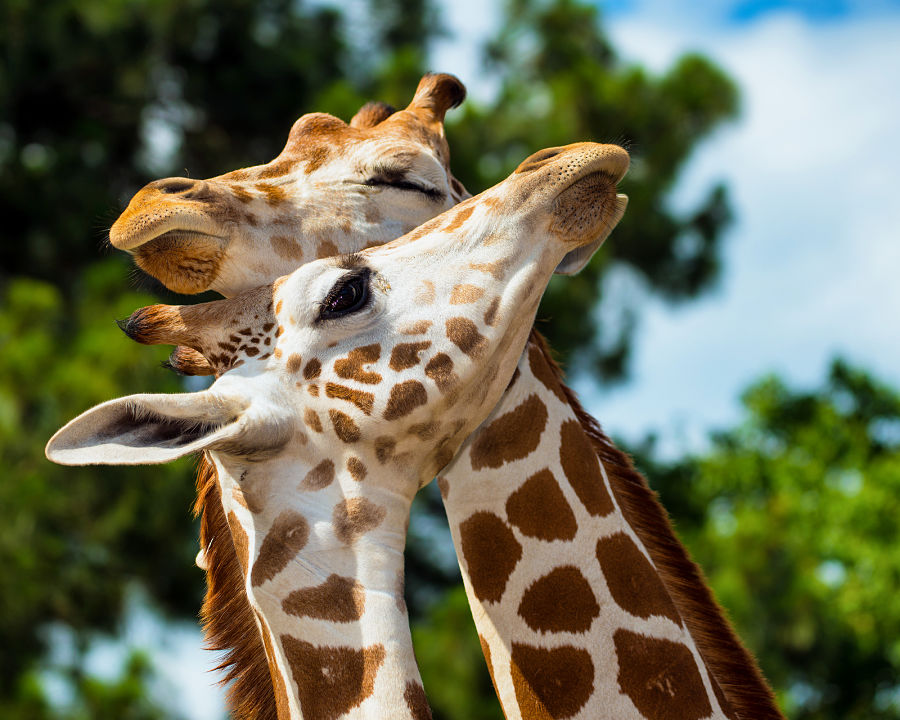 giraffes snuggling
giraffes snuggling- The giraffe is the largest ruminant and the worlds tallest animal
- Male giraffes can be 18 feet tall at the top of the horns
- Giraffes have 2 to 5 horns called "occicones"
- The giraffes neck is 6 to 8 feet long and can weigh over 600 pounds
- Giraffes "chew their cud" just like cows
- Giraffes defend themselves by kicking
- A giraffes kick can kill a lion!
- The giraffes tongue is about 18 inches long
Scientific Classification:
| Giraffe Facts - animalstats - | |||
|---|---|---|---|
| MALE | FEMALE | YOUNG | SOCIAL UNIT |
| bull | cow | calf | herd |
| HOME | HABITAT | LIFESPAN | FAVORITE FOOD |
| Africa Asia | savanna | 20-25 years | acacai leaves |
| ENEMIES | GENDER DIFFERENCE | AVG. HEIGHT | AVG. WEIGHT |
| lion | males larger | 16-18 feet | 1800-2400 pounds |
| TOP SPEED | GESTATION | BIRTHWEIGHT | BIRTHHEIGHT: |
| 37 mph | 15 months | 150 pounds | 5.5-6 feet |
| RAISED BY | # OF YOUNG | EYES OPEN | STANDS UP |
| mother | 1, rare twins | at birth | 30 mins |
| WEANED | INDEPENDENT | MATURITY | ENDANGERED? |
| 9-12 months | 15-18 months | 4-6 years | some subspecies |
see more animal extreme closeups
Recent Articles
-
African Animals - Animal Facts Encyclopedia
Oct 11, 16 10:27 PM
African Animals facts photos and videos..Africa is a wonderland for animal lovers, and a schoolroom for anyone who wants to learn about nature, beauty and the rhythm of life -
Baboon Facts - Animal Facts Encyclopedia
Oct 11, 16 10:26 PM
Baboon facts, photos, videos and information - Baboons are very distinctive looking monkeys with long, dog-like snouts and close set eyes. -
Great Apes Facts - Animal Facts Encyclopedia
Oct 11, 16 10:25 PM
Great apes facts, photos and videos..Human beings did not evolve from chimpanzees, modern chimps and gorillas do not appear in the fossil records until much more recently than homo sapiens..



